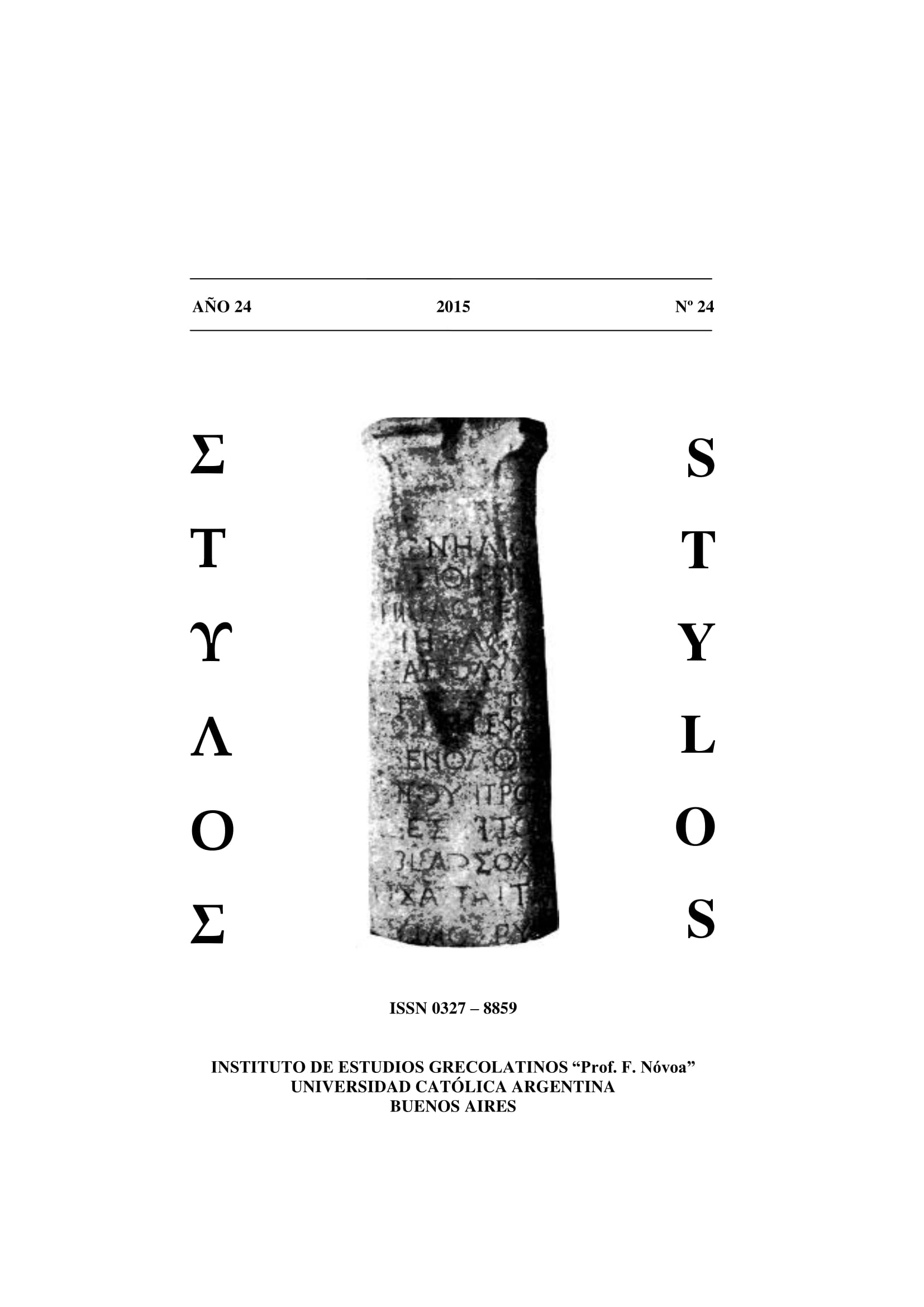QUAM OB REM INCENDOR IRA […] (TER. HEC. 562) INTERPRETAR Y TRADUCIR EMOCIONES: EL CASO DE LA IRA EN HECYRA DE TERENCIO
Keywords:
Terence, anger, emotions, lexicon fieldAbstract
The vocabulary of emotions in latin usually differ from which is taken as equivalent in modern languages. For this reason, translate the antiques emotions is not easy business, despite the existence of texts that define them accurately. In the palliata one traditional sequence is the senex iratus mentioned by Terence in the prologue of Heautontimorumenos (37). The essential element of this sequence is the anger, emotion that Aristotle defines with precision in the Rhetorica. Of all terentian corpus, Hecyra is the comedy presenting greater number of occurrences of ira lexeme and its derivatives. On this occasion, we are interested, therefore focus our attention on the analysis of this lexicon field, aiming to cast light not so much on the antique psychology but on how to translate certain basic terms of emotions.Downloads
References
EDICIONES Y COMENTARIOS
ARISTOTE. Rhétorique, texte établi et traduit par Médéric Dufour, Paris, Les Belles Lettres, 1932.
M.TULLIUS CICERO. Tusculanae disputationes, M. Pohlenz (ed), Stuttgart, Teubner, 1918.
P. TERENTI AFRI. Comoediae. Recognoverunt brevique adnotatione critica instruxerunt
R. Kauer et W. Lindsay, supplementa apparatus curavit O. Skutsch, Oxonii, etypographeo clarendoniano, 1958.
P. TERENTI. Comoediae. Cum scholiis Aeli Donati et Eugraphi Commentarius edidit R.
Klotz, volumen alterum Adelphos Hecyram Phormionem continens, Lipsiae, 1838.
P. TERENZIO AFRO. Hecyra .Introduzione e commento di Salvatore Stella, Milano, Signorelli, 1980.
TERENCE. Comédies. Tome III. Texte établi et traduit par J. Marouzeau, Paris, Les Belles Lettres, 1949.
TRADUCCIONES
PUBLIO TERENCIO AFRICANO Comedias. Introducción, versión y notas de Germán Viveros Maldonado, México, UNAM, 1975-1976.
PUBLIO TERENCIO AFRO Comedias. La Muchacha de Andros, La Suegra, Los Hermanos, Edición de Aurora López y Andrés Pociña, Madrid, Akal, 1998.
TERENCIO Comedias Completas. Traducción, notas e introducción de Hugo Francisco Bauzá, Buenos Aires, Colihue, 2007.
INSTRUMENTA STUDIORUM
A.A.V.V. Thesaurus Linguae Latina, Leipzig, 2004, (edición digital).
ERNOUT, A. – MEILLET, A. Dictionnaire étymologique de la langue latine. Histoire desmots, Paris, Klincksieck, 1967.
GAFFIOT, F. Dictionnaire latin-français, Paris, Hachette, 1990.
GLARE, P. (ed.) Oxford Latin Dictionary, Oxford, Clarendon Press, 1968.
GONZÁLEZ VÁZQUEZ, C. Diccionario del Teatro Latino. Léxico, Dramaturgia, Escenografía, Madrid, Ediciones Clásicas, Akal, 2004.
Diccionario de la lengua Española (DRAE), Madrid, 2001, 22ª edición, on-line.
BIBLIOGRAFÍA
ANDÚJAR MORENO, G. (2012), “Análisis comparativo del campo semántico del enojo en la obra L´ elégance du hérisson y en sus traducciones al castellano, catalán e inglés”, Sendebar 23, pp. 159-175.
CHÓLIZ, M. (1995), “Expresión de las emociones”, Fernández-Abascal, E. (coord.), Manual de motivación y emoción, Madrid, Centro de Estudios Ramón Areces, pp. 473-75.
DARWIN, CH. (1872, 1998), The expressions of the emotions in man and animals, London, Harper Collins.
ELSTER, J. (2002), Alquimias de la mente. La racionalidad y las emociones, Barcelona, Paidós.
FAURE RIBREAU, M. (2012), Pour la beauté du jeu. La construction des personnages dans la comédie romaine (Plaute, Térence), Paris, Les Belles Lettres.
FERNÁNDEZ PONCELA, A. (2011), “Antropología de las emociones y teoría de los sentimientos”, Revista Versión Nueva Época 26, pp. 1-24.
GUERRERO LEBRÓN, M. (2005), La injuria indirecta en Derecho Romano, Madrid,Dykinson.
JAMES, W. (1884, 2007), What is an emotion?, USA, Wilder Publications.
KASTER, R. (2005), Emotion, Restraint and Community in Ancient Rome, Oxford, Oxford University Press.
KONSTAN, D.(2001), Pity Transformed, London, Duckworth.
KONSTAN, D.(2004),“Las emociones en la antigüedad griega”, Pensamiento y Cultura, 7, 2004, pp. 47-54.
KONSTAN, D.(2006), The emotions of the Ancient Greeks: studies in Aristotle and Classical Literature, Toronto, University of Toronto Press.
LUTZ, C. (1988), Unnatural Emotions: everyday sentiments on a micronesian atoll and their challenge to western theory, Chicago, University of Chicago Press.
MOMMSEM, T. (1999), Derecho Penal Romano, Colombia, Temis.
PÉREZ NIETO, M.-REDONDO DELGADO, M.-LEÓN, L. (2008), “Aproximaciones a la emoción de ira: de la conceptualización a la intervención psicológica”, Revista electrónica de motivación y emoción XI.28. Disponible en http://reme.uji.es
RABATEL, A. (2003), “Le point de vue, entre langue et discours, description et interprétation: état de l´art et perspectivas”, Cahiers de Praxématique 41, pp. 7-24.
RENKEMA, J. (2001), “Intensificadores: un marco de análisis”, Discurso org. 1. Disponible en www.janrenkema.nl/file/artikel/intensificadores.pdf
RESINA SOLA, P. (1990), “La condición jurídica de la mujer en Roma”, en LÓPEZ, A. MARTÍNEZ, C.- POCIÑA, A. (edd), La mujer en el Mediterráneo, Granada, Universidad de Granada, 1990, pp. 97-119.
SUÁREZ, M. y ÁLVAREZ, M. (2007), “Los avatares de la iniuria en el corpus plautino”, en SUÁREZ, M. y ÁLVAREZ, M. (edd.) Un escenario para el Derecho Romano: la comedia de Plauto, Buenos Aires, Facultad de Derecho (UBA).
Downloads
Published
How to Cite
Issue
Section
License






